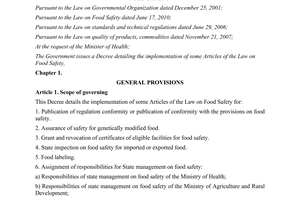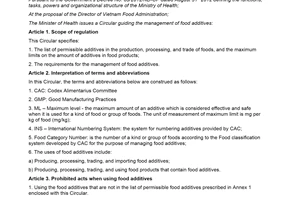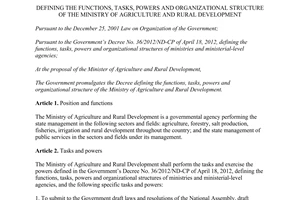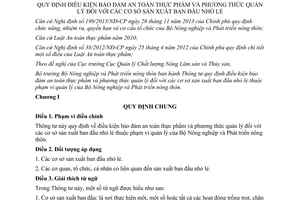Nội dung toàn văn Circular No. 51/2014/TT-BNNPTNT food safety conditions and method for managing manufacturing facilities
|
THE MINISTRY
OF AGRICULTURE AND RURAL DEVELOPMENT |
THE
SOCIALIST REPUBLIC OF VIETNAM |
|
Hanoi, December 27, 2014 |
CIRCULAR
STIPULATING FOOD SAFETY CONDITIONS AND METHOD FOR MANAGING SMALL-SCALE INITIAL MANUFACTURING FACILITIES
Pursuant to the Government’s Decree No. 199/2013/NĐ-CP dated November 26, 2013 on defining the functions, tasks, powers and organizational structure of the Ministry of Agriculture and Rural Development;
Pursuant to the Law of Food Safety introduced in 2010;
Pursuant to the Government's Decree No. 38/2012/NĐ-CP dated April 25, 2012 on specifying some articles of the Law of Food Safety;
At the request of the Director of the National Department of Agricultural - Forest – Aquacultural Product Quality Control
The Minister of Agriculture and Rural Development hereby promulgates the Circular on stipulating food safety conditions and method for managing small-scale initial manufacturing facilities under the authority of the Ministry of Agriculture and Rural Development.
Chapter I
GENERAL PROVISIONS
Article 1. Scope of application
This Circular stipulates food safety conditions and method for managing small-scale initial manufacturing facilities under the authority of the Ministry of Agriculture and Rural Development.
Article 2. Applicable entities
1. Small-scale initial manufacturing facilities.
2. Agencies, organizations or individuals engaged in small-scale initial manufacturing operations.
Article 3. Interpretation of terms
Several terms used herein shall be construed as follows:
1. Initial manufacturing facility refers to the place where one, some or all of operation(s), such as cultivation, farming, picking, harvest, catching or collection of agricultural, forest or aquacultural products, or salt production activities, are carried out.
2. Small-scale initial manufacturing facility refers to the initial manufacturing facility that supplies products to the market but keeps no Certificate of Business Registration, Certificate of Enterprise Registration or Investment Certificate, except for the followings:
a) The facility that has obtained the certificate of conformity to the requirements of farm economy practices;
b) The facility that has obtained the certificate of good agricultural practices (VietGAP);
c) Fishing vessels with the engine power of 90 CV or more.
3. Agricultural supplies, including plant seeds, varieties, livestock breeds, fertilizers, animal feeds, aqua feeds, plant protection products, veterinary medicines, chemicals, biological products, environmental treatment and remediation agents used in the agricultural and aquacultural production practices.
Chapter II
FOOD SAFETY CONDITIONS OF SMALL-SCALE INITIAL MANUFACTURING FACILITIES
Article 4. Food safety conditions of small-scale plant growth facilities
1. Location of the plant growth facility is not within the area where there is no pollution alert and food safety conditions are not met.
2. Water sources do not cause any bad impact on the product safety. Polluted, waste water is not allowed to be used for product cleansing and processing practices.
3. The facility that uses plant protection products must stick to 4 basic principles such as correct product, correct dose or amount, proper timing and correct approach; stop using these products under the manufacturer’s directions; carefully read the product label before use.
4. The facility must use fertilizers with clear origin, in a correct dose or amount and proper methods defined in the product label, user's manual or guide or under the instructions of cultivation technicians, agricultural extension officers; use well-rotted manure.
5. The facility must have equipment, instruments, packing materials, containers and means of conveyance which are suitable to manufacture, harvest and carry products, and ensure that these will not harm or poison food.
6. The manufacturing manpower has been trained and guided to adhere to the principle of good food manufacturing practices.
7. Packaging materials of plant protection products or fertilizers must be collected and dumped into closed containers at a permitted area to wait for waste treatment or destruction which helps prevent any risk of contaminating products and the manufacturing area.
8. Food safety conditions must be maintained and all of information concerning the product trading activities must be provided.
Article 5. Food safety conditions of small-scale livestock farming facilities
1. Livestock cages or farms must be separated from dwelling houses, easy to be cleaned and disinfected; must have a place to contain and decompose solid wastes, and a pit to dispose of liquid wastes, and meet the standard of veterinary and environmental hygiene and sanitation.
2. Livestock varieties or breeds must have clear origin, be healthy and vaccinated to prevent any disease under the instructions of cultivation and veterinary officers.
3. Feed and water used for livestock farming activities must be kept uncontaminated or harmless to livestock and user of livestock products.
4. Veterinary medicines, chemicals and biological products used in livestock farming activities must be used in conformity with the directions given on the product packs, user’s guide or manual, or the instructions of veterinary officers or agricultural extension officers.
5. Livestock breeders shall be trained and guided to adhere to the principle of the good food manufacturing practice.
6. Food safety conditions must be maintained and all of information concerning the product trading activities must be provided.
Article 6. Food safety conditions of small-scale aquaculture facilities
1. The facility must ensure that location and water source used for aquacultural practices must conform to the food safety standard.
2. The facility is required to use healthy aquatic breeds with clear origin.
3. The facility must ensure that the aquatic feed does not harm aquatic products and the user of such aquatic products and the user of aquatic products. It is not permissible to use animal and human wastes for aquacultural practices.
4. Veterinary medicines, chemicals and biological products, environmental remediation agents used for aquacultural practices must conform to the user's directions printed on product packs or under the instructions of aquaculture technicians or agricultural extension officers.
5. The pond water must be treated before being discharged into the surrounding area to prevent the spread of disease that aquatic animals may have during aquacultural practice period. Waste sludge disposed from these aquaculture ponds must be collected and treated to prevent any impact on the surrounding environment.
6. Post-harvest aquatic products must be stored and shipped by means of proper equipment and devices which help prevent food from being poisoned or contaminated.
7. Aquatic breeders shall be trained and guided to adhere to the principle of the good food manufacturing practice.
8. Food safety conditions must be maintained and all of information concerning the product trading activities must be provided.
Article 7. Food safety conditions of small-scale salt production facilities
1. The place where salt production facility is located must be within the zoned area designated by local authorities and have the traffic system used for salt shipping activities.
2. The channel system used for supplying salt water for salt production practices and rainwater disposal system must be developed while the facility does not cause the salt attack on the surrounding environment.
3. Seawater source and saline water source used for salt production activities are not contaminated and conform to the food safety standards.
4. Seawater supply system for the salt field must be separated from the system used for disposing of sewage or waste water discharged from other facilities.
5. Equipment, device and transport used for manufacturing, harvest, shipping and storage of salt products must meet the accepted standard and ensure that salt will not be contaminated.
6. Salt farmers shall be trained and guided to adhere to the principle of the good food manufacturing practice.
7. Food safety conditions must be maintained and all of information concerning the product trading activities must be provided.
Article 8. Food safety conditions of small-scale facilities that harvest, catch and collect agricultural and forest products
1. The facility must have equipment, instruments, packing materials, containers and means of conveyance which are suitable to harvest, pick, catch, store and ship products, and ensure that these will not harm or poison food.
2. Products after being harvested, caught or collected must be stored to meet the specific requirement of each product to ensure that these products shall be kept fresh, alive, or preliminarily treated, frozen or dried. In case additives or chemicals are used for food preservation or processing activities, these must conform to the instructions under which permitted types of additives or chemicals are defined, and must have clear labels, packs and origin (under the provisions of the Circular No. 27/2012/TT-BYT of the Minister of Health dated November 30, 2012 on providing guidance on the management of food additives).
3. The person who harvests, catches, stores and carries products shall be trained and guided to adhere to the principle of the good food manufacturing practice.
4. Food safety conditions must be maintained and all of information concerning the product trading activities must be provided.
Chapter III
METHOD FOR MANAGING SMALL-SCALE INITIAL MANUFACTURING FACILITIES
Article 9. Managerial method
The method for managing food safety conditions of small-scale initial manufacturing facilities shall be implemented through the signing of commitment, inspection and imposition of penalties on commitment-defaulting facilities.
Article 10. Signing of commitments
1. In-charge agencies shall disseminate and provide guidance on good food manufacturing practices and make small-scale initial manufacturing facilities get involved in the signing of commitment on their conformance to the food safety standards for their food manufacturing activities.
2. The commitment content shall conform to the form given in the Appendix I attached hereto.
3. Commitment signing maturity date: every 3 years.
Article 11. Inspection
1. With respect to the inspection of fulfillment of commitments that small-scale initial manufacturing facilities had made, in-charge agencies shall adhere to the annual inspection plan approved by the People's Committee at all levels. The inspection record shall conform to the form given in the Appendix II attached hereto.
2. As for the spontaneous inspection, in-charge agencies shall carry out the spontaneous inspection when any food safety incident takes place or it is required by the superior managing agency.
Article 12. Imposition of penalties on commitment-defaulting facilities
1. As for those defaulting on their commitments for the first time: In-charge agencies shall remind them to comply with their commitments.
2. As for those defaulting on their commitments for the second time: In-charge agencies shall make their default on commitment on good food manufacturing practices known to the public.
3. As for those committing violations against their commitments which result in severe consequences or those defaulting on their commitments for the third time or more: Depending on the severity of such violation, in-charge agencies shall request competent authorities to handle such violations under the provisions of applicable laws.
Chapter IV
IMPLEMENTATION
Article 13. Implementation
1. The provincial People’s Committee:
a) Assign and delegate a competent agency to manage small-scale initial manufacturing facilities within their localities.
b) Direct the Department of Finance and other relevant Departments to advise, arrange resources and budget for the task of managing local small-scale initial manufacturing facilities.
2. The Department of Agriculture and Rural Development located in a centrally-affiliated city or province:
a) Consult with the provincial People’s Committee on stipulating the agency in charge of managing small-scale initial manufacturing facilities that fall within their delegated authority.
b) Direct and provide guidance on implementation of this Circular throughout their localities; train and instruct the in-charge agency to carry out their assigned tasks.
c) Making a report on the implementation result for submission to the Ministry of Agriculture and Rural Development (forwarded by the National Department of the Agriculture - Forest – Aquaculture Product Quality Control) in accordance with the current reporting regime.
3. The agency assigned the power to manage small-scale initial manufacturing facilities:
a) Disseminate and provide guidance on good food manufacturing practices and make small-scale initial manufacturing facilities that fall within their delegated authority get involved in the signing of commitment on their conformance to the food safety standards for their food manufacturing practices.
b) Draw up the plan to inspect the fulfillment of commitments that these small-scale initial manufacturing facilities have made for submission to the People's Committee at all levels for approval and distribution of funds for the implementation.
c) Inspect the fulfillment of commitments that small-scale initial manufacturing facilities have made in accordance with the approved inspection plan.
d) Make the list of small-scale initial manufacturing facilities defaulting on their commitments to conforming to the requirements of good food manufacturing practices known to the public through mass media.
dd) Store documentation concerning the inspection of fulfillment of commitments that small-scale initial manufacturing facilities have made in a systematic manner.
e) Making a report on the implementation result for submission to the Department of Agriculture and Rural Development (forwarded by the Subdepartment of the Agriculture - Forest – Aquaculture Product Quality Control) in accordance with the current reporting regime.
4. The Subdepartment of the Agriculture - Forest – Aquaculture Product Quality Control shall be responsible for providing guidance on implementation of this Circular across the nation.
5. Small-scale initial manufacturing facilities shall be responsible for strictly fulfilling their commitments on the good food manufacturing practices, providing relevant information about any sign of food safety violations, and shall be subjected to the inspection conducted by regulatory agencies.
Chapter V
IMPLEMENTARY PROVISIONS
Article 14. Effect
This Circular shall come into force from February 10, 2015.
Article 15. Amendment or modification
In the course of implementation, if there is any difficulty that may arise, agencies concerned should report it to the Ministry of Agriculture and Rural Development (forwarded by the Department of the Agriculture – Forest – Aquaculture Product Quality Control) for any consideration, amendment or modification ./.
|
|
THE MINISTER |
APPENDIX I
FORM OF COMMITMENT TO CONFORM TO REQUIREMENTS FOR
THE GOOD FOOD MANUFACTURING PRACTICE
(Issued together with the Circular No. 51/2014/TT-BNNPTNT of the Ministry of
Agriculture and Rural Development dated December 27, 2014)
THE SOCIALIST
REPUBLIC OF VIETNAM
Independence - Freedom - Happiness
--------------------------
………, date:.............
COMMITMENT
To conform to the requirements for good food manufacturing practices
Dear:……….(name of the in-charge agency assigned by the People's Committee of a province or city)
My name is………………
ID card No.:………………. Issuance date:.................... Issuance place:..................
The owner of the manufacturing facility:……………………………………
The location of the manufacturing facility:……………………………………
Contact address:………………………………………………………………………..
Telephone:……………………., Fax:………………….. Email address:………………
The product range:……………………………………
The consumption market:
I undertake that all requirements for the good food manufacturing practices mentioned in page 2 of this commitment shall be fully met in terms of the manufacturing sector as follows
Plant cultivation □ Animal breeding □
Aquatic breeding □ Salt production □
Harvest, catching and collection of agricultural and forest products □
(Mark X to the box specifying the manufacturing type and make a commitment in the following page of this Commitment).
If there is any violation, we shall fully take our legal responsibility.
This Commitment shall be made into 02 copies with the same legal value. Each of 2 copies shall be kept by the in-charge agency and the facility.
|
|
The owner of the manufacturing facility (Signature and full name) |
Regulation on food safety conditions of small-scale initial manufacturing facilities
|
1. As for small-scale plant growth facilities (In accordance with Article 4 of the Circular No. 51/2014/TT-BNNPTNT) 1. Location of the plant growth facility is not within the area where there is no pollution alert and food safety conditions are not met. 2. Water sources do not cause any bad impact on the product safety. Polluted, waste water is not allowed to be used for product cleansing and preliminary treatment. 3. The user of plant protection products must stick to 4 basic principles such as correct product, correct dose or amount, proper timing and correct approach; stop using these products under the manufacturer’s directions; carefully read the product label before use. 4. The facility must use fertilizers with clear origin, a correct dose or amount and proper methods defined in the product label, user's manual or guide or under the instructions of cultivation technicians, agricultural extension officers; use well-rotted manure. 5. The facility must have equipment, instruments, packing materials, containers and means of conveyance which are suitable to manufacture, harvest and carry products, and ensure that their products will not harm or poison food. 6. The manufacturing manpower has been trained and guided to adhere to the principle of good food manufacturing practices. 7. Packaging materials of plant protection products or fertilizers must be collected and dumped into closed containers at a permitted area to wait for waste treatment or destruction which helps prevent any risk of contaminating products and manufacturing area. 8. Food safety conditions must be maintained and all of information concerning the product trading activities must be provided. |
2. As for small-scale livestock farming facilities (In accordance with Article 5 of the Circular No. 51/2014/TT-BNNPTNT) 1. Livestock cages or farms must be separated from dwelling houses, easy to be cleaned and disinfected; must have a place to contain and decompose solid wastes, and a pit to dispose of liquid wastes, and meet the standard of veterinary and environmental hygiene and sanitation. 2. Livestock varieties or breeds must have clear origin, be healthy and vaccinated to prevent any disease under the instructions of cultivation and veterinary officers. 3. Feed and water used for farming activities must be kept uncontaminated or harmless to livestock and user of livestock products. 4. Veterinary medicines, chemicals and biological products used in livestock farming activities must be used in conformity with the directions given on the product packs, user’s guide or manual, or the instructions of veterinary officers or agricultural extension officers. 5. Livestock breeders shall be trained and guided to adhere to the principle of the good food manufacturing practice. 6. Food safety conditions must be maintained and all of information concerning the product trading activities must be provided. |
|
3. As for aquaculture facilities (In accordance with Article 6 of the Circular No. 51/2014/TT-BNNPTNT) 1. The facility must ensure that location and water source used for aquacultural practices must conform to the food safety standard. 2. The facility is required to use healthy aquatic breeds with clear origin. 3. The facility must ensure that the aquatic feed does not harm aquatic products and the user of such aquatic products and the user of aquatic products. It is not permissible to use animal and human wastes for aquacultural practices. 4. Veterinary medicines, chemicals and biological products, environmental remediation agents used for aquacultural practices must conform to the user's directions printed on product packs or under the instructions of aquaculture technicians or agricultural extension officers. 5. The pond water must be treated before being discharged into the surrounding area to prevent the spread of disease that aquatic animals may have during aquacultural practice period. Waste sludge disposed from these aquaculture ponds must be collected and treated to prevent any impact on the surrounding environment. 6. Post-harvest aquatic products must be stored and shipped by means of proper equipment and devices which help prevent food from being poisoned or contaminated. 7. Aquatic breeders shall be trained and guided to adhere to the principle of the good food manufacturing practice. 8. Food safety conditions must be maintained and all of information concerning the product trading activities must be provided. |
4. As for small-scale salt production facilities (In accordance with Article 7 of the Circular No. 51/2014/TT-BNNPTNT) 1. The place where salt production facility is located must be within the zoned area designated by local authorities and have the traffic system used for salt shipping activities. 2. The channel system used for supplying salt water for salt production practices and rainwater disposal system must be developed while the facility does not cause the salt attack on the surrounding environment. 3. Seawater source and saline water source used for salt production activities are not contaminated and conform to the food safety standards. 4. Seawater supply system for the salt field must be separated from the system used for disposing of sewage or waste water discharged from other facilities. 5. Equipment, device and transport used for manufacturing, harvest, shipping and storage of salt products must meet the accepted standard and ensure that salt will not be contaminated. 6. Salt farmers shall be trained and guided to adhere to the principle of the good food manufacturing practice. 7. Food safety conditions must be maintained and all of information concerning the product trading activities must be provided. |
|
5. As for small-scale facilities that harvest, catch and collect agricultural and forest products (In accordance with Article 8 of the Circular No. 51/2014/TT-BNNPTNT) 1. The facility must have equipment, instruments, packing materials, containers and means of conveyance which are suitable to harvest, pick, catch, store and ship products, and ensure that these will not harm or poison food. 2. Products after being harvested, caught or collected must be stored to meet the specific requirement of each product to ensure that these products shall be kept fresh, alive, or preliminarily treated, frozen or dried. In case additives or chemicals are used for food preservation or processing activities, these must conform to the instructions under which permitted types of additives or chemicals are defined, and must have clear labels, packs and origin (under the provisions of the Circular No. 27/2012/TT-BYT of the Minister of Health dated November 30, 2012 on providing guidance on the management of food additives). 3. The person who harvests, catches, stores and carries products shall be trained and guided to adhere to the principle of the good food manufacturing practice. 4. Food safety conditions must be maintained and all of information concerning the product trading activities must be provided. |
|
APPENDIX II
FORM OF INSPECTION RECORD TO INSPECT FULFILLMENT OF
COMMITMENT TO CONFORM TO THE GOOD FOOD MANUFACTURING PRACTICE OF SMALL-SCALE
INITIAL MANUFACTURING FACILITIES
(Issued together with the Circular No. 51/2014/TT-BNNPTNT of the Ministry of
Agriculture and Rural Development dated December 27, 2014)
|
(NAME OF THE
INSPECTION AGENCY) |
THE
SOCIALIST REPUBLIC OF VIETNAM |
INSPECTION RECORD
To inspect fulfillment of commitment to conform to the good food manufacturing practice of small-scale initial manufacturing facilities
I. GENERAL INFORMATION:
1. Name of the manufacturing facility:
Address:
3. Telephone number: Fax number (if any):
4. Code (if any):
5. Product range:
6. The facility undertakes that all requirements for the good food manufacturing practices shall be fully met in terms of the manufacturing sector as follows
Plant cultivation □ Animal breeding □
Aquatic breeding □ Salt production □
Harvest, catching and collection of agricultural and forest products □
7. The number of man force directly engaged in manufacturing activities:
7. Inspection date:
9. The inspection team shall be composed of:
1)
2)
10. Representative of the manufacturing facility:
1)
2)
II. ASSESSMENT OF CONFORMITY TO THE REQUIREMENTS FOR GOOD FOOD MANUFACTURING PRACTICES
|
No. |
Commitment content |
With reference to Clause and Article enshrined in the Circular 51/2014/TT-BNNPTNT |
Implementation result |
Reasons for “fail” result and remedial measures recommended to be taken |
|
|
Pass |
Fail |
|
|||
|
I |
Conformity to all requirements for the good food manufacturing practices in the manufacturing sector…….. |
Clause...Article... |
|
|
|
|
Clause...Article... |
|
|
|
||
|
Clause...Article... |
|
|
|
||
|
Clause...Article... |
|
|
|
||
|
Clause...Article... |
|
|
|
||
|
Clause...Article... |
|
|
|
||
|
Clause...Article... |
|
|
|
||
|
Clause...Article... |
|
|
|
||
|
II |
Conformity to all requirements for the good food manufacturing practices in the manufacturing sector…….. |
Clause...Article... |
|
|
|
|
|
|
|
|
||
|
|
|
|
|
||
|
|
|
|
|
||
|
|
|
|
|
||
|
III |
|
|
|
|
|
III. REMARKS AND RECOMMENDATIONS OF THE INSPECTION TEAM:
IV. OPINIONS OF THE MANUFACTURING FACILITY’S REPRESENTATIVE
V. INSPECTION CONCLUSION:
|
REPRESENTATIVES OF THE MANUFACTURING FACILITY (Signature and full name) |
.............., date:……….. LEADER OF THE INSPECTION TEAM (Signature and full name) |
------------------------------------------------------------------------------------------------------
This translation is made by LawSoft and
for reference purposes only. Its copyright is owned by LawSoft
and protected under Clause 2, Article 14 of the Law on Intellectual Property.Your comments are always welcomed




